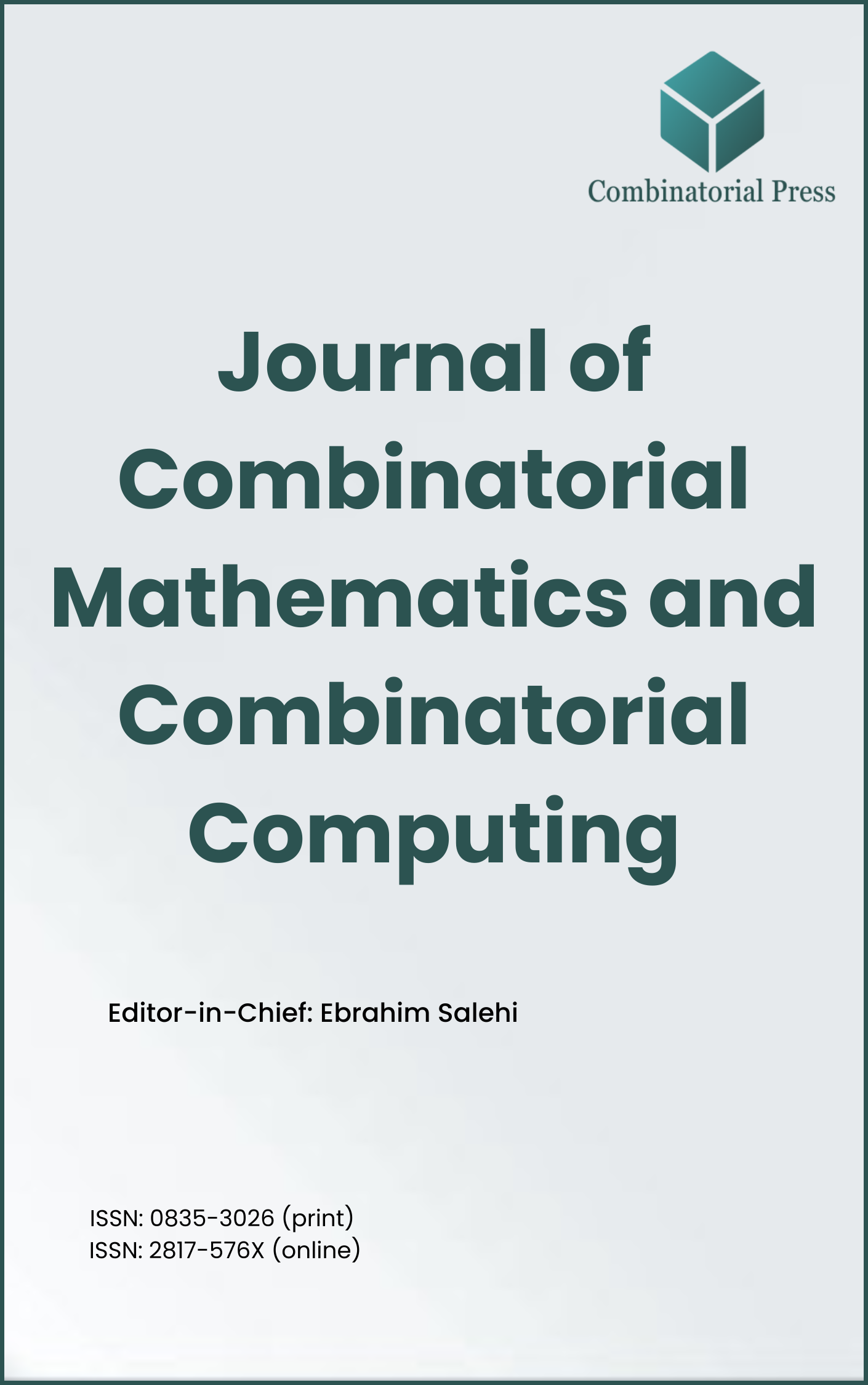
Journal of Combinatorial Mathematics and Combinatorial Computing
ISSN: 0835-3026 (print) 2817-576X (online)
The Journal of Combinatorial Mathematics and Combinatorial Computing (JCMCC) embarked on its publishing journey in April 1987. From 2024 onward, it publishes four volumes per year in March, June, September and December. JCMCC has gained recognition and visibility in the academic community and is indexed in renowned databases such as MathSciNet, Zentralblatt, Engineering Village and Scopus. The scope of the journal includes; Combinatorial Mathematics, Combinatorial Computing, Artificial Intelligence and applications of Artificial Intelligence in various files.
- Research article
- Full Text
- Journal of Combinatorial Mathematics and Combinatorial Computing
- Volume 001
- Pages: 207-215
- Published: 30/04/1987
- Research article
- Full Text
Let the vertices of a graph denote computer processes which communicate by passing messages along edges. It has been a standard Computer Science problem to provide algorithms that let the processes solve problems jointly (e.g. leader election, clock synchronization). What if some of the processes are maliciously faulty, i.e. send messages calculated to sabotage joint algorithms? Here we review a few “byzantine agreement” algorithms with interesting graph-theoretic features and raise questions about graph connectivity and diameter (with a few answers).
- Research article
- Full Text
- Journal of Combinatorial Mathematics and Combinatorial Computing
- Volume 001
- Pages: 181-190
- Published: 30/04/1987
Let the vertices of a graph denote processes in a distributed or time-shared computer system; let two vertices be connected by an edge if the two processes cannot proceed at the same time (they mutually exclude one another). Managing mutual exclusion and related scheduling problems has given rise to substantial literature in computer science. Some methods of attack include covering or partitioning the graph with cliques or threshold graphs. Here I survey some recent graph-theoretic results and examples motivated by this approach.
- Research article
- Full Text
- Journal of Combinatorial Mathematics and Combinatorial Computing
- Volume 001
- Pages: 175-180
- Published: 30/04/1987
- Research article
- Full Text
- Journal of Combinatorial Mathematics and Combinatorial Computing
- Volume 001
- Pages: 149-174
- Published: 30/04/1987
A triangle in a Steiner triple system \(S\) is a triple of blocks from \(S\) which meet pairwise and whose intersection is empty. If \(S\) contains \(b\) blocks, and \(b = 3q + 8\), where \(0 \leq 8 \leq 2\), then a triangulation of \(S\) is a collection of \(q\) triangles \(\{T_1, T_2, \ldots, T_q\}\) in \(S\) such that no two distinct triangles share a common block. It is shown that, for \(v \equiv 1\) or \(3 \pmod{6}\), there exists a Steiner triple system which admits a triangulation. Moreover, if \(8 = 2\), there is a triangulated triple system in which the pair of blocks not occurring in a triangle are disjoint, and a triangulated triple system in which they intersect.
- Research article
- Full Text
- Journal of Combinatorial Mathematics and Combinatorial Computing
- Volume 001
- Pages: 141-148
- Published: 30/04/1987
- Research article
- Full Text
- Journal of Combinatorial Mathematics and Combinatorial Computing
- Volume 001
- Pages: 131-140
- Published: 30/04/1987
The polynomial algorithms for isomorphism testing in \(3\)-regular graphs known to date use set-wise stabilisation in \(2\)-groups acting on singletons, pairs, and sometimes triples of vertices. In this note we describe a new, simpler way of “getting rid of the triples”. Although the order of the complexity of isomorphism testing remains \(O(\text{n}^3 \log \text{n})\), the resulting algorithm is more efficient, since this portion of the set-wise stabilisation in the algorithm will be faster.
- Research article
- Full Text
- Journal of Combinatorial Mathematics and Combinatorial Computing
- Volume 001
- Pages: 125-130
- Published: 30/04/1987
In thie paper, various constructions for resolvable group divisible designs with block size \(4\) are given.
- Research article
- Full Text
- Journal of Combinatorial Mathematics and Combinatorial Computing
- Volume 001
- Pages: 115-124
- Published: 30/04/1987
A group satisfies PP3 (the permutation property of degree \(3\)) if any product of \(3\) elements remains invariant under some nontrivial permutation of its factors, or equivalently, if \(G\) has at most one nontrivial commutator of order \(2\). A PP3 group is \(\underline{\text{elementary}}\) if it is a finite group of exponent at most \(4\). There is an algorithm that associates an elementary PP3 group to an arbitrary graph. It follows, for instance, that almost every nontrivial graph automorphism has order a power of \(2\) and that the first-order theory of (elementary) PP3 groups is hereditarily undecidable.
- Research article
- Full Text
- Journal of Combinatorial Mathematics and Combinatorial Computing
- Volume 001
- Pages: 107-114
- Published: 30/04/1987
A generalization of Sperner’s labeling for simplices is considered. It allows us to give any label not only to points from the interior of the simplex but also to points from the relative interior of each facet, while the Sperner labeling rule is preserved for all points on the boundary of each facet. Some properties of this labeling and its behavior on the facets of the simplex are discussed. Also, necessary and sufficient conditions for the existence of an odd number of completely labelled simplices in any triangulation of the simplex are given.





